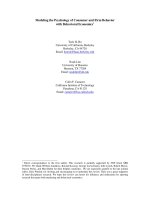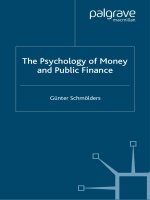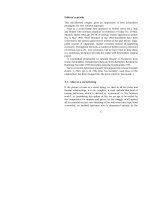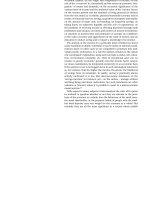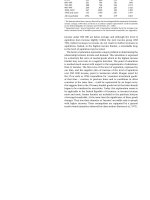financial risk taking-an intro to the psychology of tr and behav fin - elvin 2004
Bạn đang xem bản rút gọn của tài liệu. Xem và tải ngay bản đầy đủ của tài liệu tại đây (3.11 MB, 294 trang )
Financial Risk Taking
WILEY TRADING SERIES
Financial Risk Taking: An Introduction to the Psychology of Trading and
Behavioural Finance
Mike Elvin
Single Stock Futures: A Trader’s Guide
Patrick L. Young and Charles Sidey
Uncertainty and Expectation: Strategies for the Trading of Risk
Gerald Ashley
Bear Market Investing Strategies
Harry D. Schultz
The Psychology of Finance, revised edition
Lars Tvede
The Elliott Wave Principle: Key to Market Behavior
Robert R. Prechter
International Commodity Trading
Ephraim Clark, Jean-Baptiste Lesourd and Ren
´
eThi
´
eblemont
Dynamic Technical Analysis
Philippe Cahen
Encyclopedia of Chart Patterns
Thomas N. Bulkowski
Integrated Technical Analysis
Ian Copsey
Financial Markets Tick by Tick: Insights in Financial Markets Microstructure
Pierre Lequeux
Technical Market Indicators: Analysis and Performance
Richard J. Bauer and Julie R. Dahlquist
Trading to Win: The Psychology of Mastering the Markets
Ari Kiev
Pricing Convertible Bonds
Kevin Connolly
At the Crest of the Tidal Wave: A Forecast for the Great Bear Market
Robert R. Prechter
FINANCIAL RISK TAKING
An Introduction to the Psychology of Trading
and Behavioural Finance
Mike Elvin
Copyright 2004 John Wiley & Sons Ltd, The Atrium, Southern Gate, Chichester,
West Sussex PO19 8SQ, England
Telephone (+44) 1243 779777
Email (for orders and customer service enquiries):
Visit our Home Page on www.wileyeurope.com or www.wiley.com
All Rights Reserved. No part of this publication may be reproduced, stored in a retrieval system or
transmitted in any form or by any means, electronic, mechanical, photocopying, recording,
scanning or otherwise, except under the terms of the Copyright, Designs and Patents Act 1988 or
under the terms of a licence issued by the Copyright Licensing Agency Ltd, 90 Tottenham Court
Road, London W1T 4LP, UK, without the permission in writing of the Publisher. Requests to the
Publisher should be addressed to the Permissions Department, John Wiley & Sons Ltd, The
Atrium, Southern Gate, Chichester, West Sussex PO19 8SQ, England, or emailed to
, or faxed to (+44) 1243 770620.
This publication is designed to provide accurate and authoritative information in regard to the
subject matter covered. It is sold on the understanding that the Publisher is not engaged in
rendering professional services. If professional advice or other expert assistance is required, the
services of a competent professional should be sought.
Other Wiley Editorial Offices
John Wiley & Sons Inc., 111 River Street, Hoboken, NJ 07030, USA
Jossey-Bass, 989 Market Street, San Francisco, CA 94103-1741, USA
Wiley-VCH Verlag GmbH, Boschstr. 12, D-69469 Weinheim, Germany
John Wiley & Sons Australia Ltd, 33 Park Road, Milton, Queensland 4064, Australia
John Wiley & Sons (Asia) Pte Ltd, 2 Clementi Loop #02-01, Jin Xing Distripark, Singapore 129809
John Wiley & Sons Canada Ltd, 22 Worcester Road, Etobicoke, Ontario, Canada M9W 1L1
Wiley also publishes its books in a variety of electronic formats. Some content that appears
in print may not be available in electronic books.
Library of Congress Cataloging-in-Publication Data
Elvin, Mike.
Financial risk taking : an introduction to the psychology of trading and
behavioural finance / Mike Elvin.
p. cm.
Includes bibliographical references and index.
ISBN 0-470-85026-4 (alk. paper)
1. Stocks – Psychological aspects. 2. Speculation – Psychological aspects.
3. Investments – Psychological aspects. I. Title.
HG6041.E48 2004
332.6
01
9–dc22
2004002789
British Library Cataloguing in Publication Data
A catalogue record for this book is available from the British Library
ISBN 0-470-85026-4
Typeset in 10/12pt Times by Laserwords Private Limited, Chennai, India
Printed and bound in Great Britain by MPG Limited, Bodmin, Cornwall
This book is printed on acid-free paper responsibly manufactured from sustainable forestry
in which at least two trees are planted for each one used for paper production.
List of Figures
Figure 3.1 The Comprehensive MOT 46
Figure 3.2 Example of technical analysis 69
Figure 3.3 Trading and decision diary 73
Figure 3.4 Candle chart 74
Figure 3.5 Equity chart 75
Figure 4.1 The Yerkes-Dodson law of arousal 95
Figure 6.1 The brain and limbic system 156
Figure 7.1 General centring triangle 187
Figure 7.2 Trading centring triangle 188
To my parents, and my son Lewis, through whom my life
has been greatly enriched.
To traders everywhere, who have had the courage,
determination, and vision to walk upon a unique path.
Contents
List of Figures ix
Foreword xi
Contrarian Investment Strategies xiii
Acknowledgements xv
1 Introduction: Between Scylla and Charybdis 1
2 Understanding Trading Competence 13
3 A Comprehensive Model of Trading Competence 45
Part A: The Tactical Model of Trading Competence 47
Part B: The Strategic Model of Trading Competence 59
4 Taming Stress to Become a Better Trader 83
5 The Psychology of Perceptual Bias 123
6 Emotions, Emotional Intelligence, and the Trader 151
7 Martial Arts and Budo Zen – Controlling Fear and Self-Sabotage 179
8 Standards and Criteria for Trading Competence 219
Appendix 1 Reading List 235
Appendix 2 Websites of Interest 239
Appendix 3 Courses and Seminars 243
Bibliography 247
Index 257
Foreword
My trading career stumbled last Friday. I sabotaged myself in an old, familiar
way: with too much risk, after too little sleep, layering risk upon risk after that
first, losing trade. For months my miniature hedge fund had been doing well.
Then, 90 hours ago, I gave away weeks of painstaking profit in an afternoon of
exhausted madness.
I have my excuses, of course. I have been under strain. The trades will turn
out to be correct. But I should have remembered what is in these pages.
This is an interesting book, an unusual and lateral response to the trader’s
condition. You will not find much in here about how or when to trade, and yet
you will find everything. The way you view this book will determine whether
you join the 10% of successful traders or the 90% who lose.
That is because the author, Dr Mike Elvin, is a trader and a psychologist. He has
had his own, terrible lessons at the home-trader’s keyboard, with the professional
background to analyse them. On page 75 you will find a chart revealing that he
knows how to trade, doubling his account equity in three months. But first you
will discover his old moments of frozen terror, sweating and shaking as he directs
his mouse to enter an order. The honesty of the book, in contrast to most guru
literature, is one of its strengths.
The main strength is the subject matter. You are the most important variable
in the trading equation. Not you, the set of technical indicators, or you, the
fundamentalist with an insight into economies and companies. I mean you, the
thinking, feeling human being. A good trader can make any strategy work, and
a poor one will lose money over time regardless of method. A good trader, like
a good parent, employee or lover, needs self-knowledge above all.
One of life’s challenges is to live in the present, and this book will help you
to live in the trading present. Absorb what Dr Elvin has to say and there is a
xii Foreword
chance, albeit a small one, that you will succeed. The risk that you will destroy
yourself is still great because you are human, and human nature never changes.
But the survival guide is in your hands.
Tim Rayment
Yorkshire, England
January 2004
Contrarian Investment Strategies
Psychology is the reason for both the consistently superior performance of the
methods the financial academics cannot explain, as well as the consistently poorer
results of those approaches that fail. Yet, psychology is not only misunderstood,
but ruled out at source (sic) by most of the current generation of financial scholars.
The study of investor behavior in markets is still in an embryonic stage.
Although we can statistically trace pattern after pattern of investor behavior,
we know little of the dynamics of the complex interactions of cognitive, group,
and other psychological forces that underlie them.
Psychology offers the marketplace the opportunity to gain a much clearer
understanding of what causes predictable behavior. The marketplace in turn offers
the various branches of psychology a major laboratory to pinpoint patterns of
behavior unlikely to be as statistically documented in such depth anywhere else.
David Dreman, (2002, p. 397)
Acknowledgements
My heart felt thanks and gratitude to Tom Williams, Director of Genie Software
and author of The Undeclared Secrets That Drive the Stock Market, who through
his friendship, guidance, and mentorship, inspired and encouraged me to achieve
what I could. Also, for his practical support and introductions to traders during
the years of research and writing of this book.
My gratitude to Dr Richard McCall, who tutored me in the way of trading
discipline and for allowing me to paraphrase the contents of his personal lectures
and writings.
To Professor Keith Oatley, Head of Psychology at Toronto University, for his
advice regarding research in the complex field of emotions, for permission to use
some of the contents of his book Understanding Emotions, and for his friendship
over the years.
My thanks to Professor Jennifer Jenkins of Toronto University for allowing me
to paraphrase some of her work which was jointly written with Professor Oatley.
I thank Professor Fenton O’Creevy, Head of the Business School at The Open
University, who allowed me to interview him in depth and for kindly forwarding
a number of recent research papers to me.
My thanks to Mark Douglas, author of The Disciplined Trader and Trading
in the Zone, for reading my draft manuscript and making excellent suggestions.
Also, for sharing with me his personal thoughts regarding trading, life in general,
and his generosity of spirit.
My thanks to Richard Smitten, author of Jesse Livermore: The World’s Greatest
Trader for reading a draft copy of my book and allowing me to interview him on
more than one occasion regarding his personal understanding of Jesse Livermore
and the relationships in his life.
I am grateful to Michael Feeny, Senior Trader at Sumitomo Mitsui Banking
Corporation, City of London, for reading a draft of my book, making helpful
comments, and for assisting me to understand the trading culture in invest-
ment banking.
My thanks to James Montier, Head of Strategy at Dresdner Kleinwort Wasser-
stein, for sharing his insights with me on behavioural finance and giving me
xvi Acknowledgements
a number of research papers he wrote since his book Behavioural Finance
was written.
My thanks to Daniel Goleman, author of Emotional Intelligence, for giving me
permission to paraphrase from his books.
To Peter Schaapveld, Consultant Forensic and Clinical Psychologist, for read-
ing a draft of the book and offering helpful comments.
My sincere thanks to Paul Gould, Webmaster of Trade2Win, and to Alan Rich,
Group Moderator and Market Trainer, for reading draft chapters of my book. The
comments were used to good effect.
My thanks to Symon Price at Mental Health Concerns & Issues for sending
me many useful research documents and website links.
My gratitude to Helen Quenet, Webmaster of ThePitTrader, for reading draft
chapters of my book, giving me charting data, and inviting me to take part
in seminars.
My sincere thanks to E. Hirsch, J. Joachim, T. Greenwood, and E. Ford, for
reading the draft manuscript and making helpful comments as fellow traders.
Also to Roy Didlock of TraderGuide Systems for offering useful charts and
comments.
My sincere thanks to “Kappa” and 37 other home traders, who gave me valu-
able data on trading styles and personality, but who wished to remain anonymous.
My sincere gratitude for the support given to me by Chris Swain and Rachael
Wilkie (editor) at John Wiley & Sons (publishers). It took longer than we thought!
My thanks to Dr Alex Elder for allowing me to paraphrase some of his work.
My gratitude to Mr K of the FSA for permission to publish his comments
regarding training.
My sincere thanks to Lewis Borsellino for allowing me to interview him
between the 9th and 18th holes, and helping me to understand the nature of
open outcry trading at the Chicago Mercantile Exchange.
Also, my sincere thanks to Girma Mesfin, who has given me encouragement
and support over the years of writing this book and who has shown me by
example that perseverance will eventually result in success.
My sincere thanks to Sonia Stevens and Sue Bradbury, both of whom typed a
significant amount of this book and who make a tremendous effort to ensure all
documents were completed quickly.
And finally, to my friend and trading colleague, Tim Rayment, a very talented
trader and award winning journalist, who gave me helpful comments on the
manuscript and spent a considerable amount of time writing the Foreword to this
book. I am indebted for this kindness.
Mike Elvin 2004
1
Introduction: Between Scylla
and Charybdis
‘‘The winds and the waves are always on the side of the ablest navigators.’’
Edward Gibbons
This book is written for people of moderate income engaged in risking their
personal finances on a speculative venture. It is for the brave new world of stock
and futures day trading, spread betting, options hedging, or any activity requiring
courage owing to financial and personal risk.
For the purposes of this book, “risk” is defined as the coexistence of danger
and opportunity; where there is uncertainty in relation to future outcome. The
seductive blend of danger and opportunity has a powerful allure and the challenge
of day trading is fraught with dangers, not normally associated with traditional
employment. If you have one, two or three degrees, diplomas, MBAs, whatever,
you have no advantage over an astute corner shop newspaper vendor or a street
flower salesman. In fact, a hypothesis has been suggested to the contrary; that
people with professional qualifications need to “unlearn” their cognitive schema
to engage the venture unencumbered by predispositions.
The substance of the book has been drawn from two sources: first, from my per-
sonal experience of changing professions in my late thirties from a relatively safe
career of managing mental health services in London, England, to that of a stock
index futures trader; second, from the large volumes of academic research papers
and related literature in the fields of experimental psychology, occupational and
performance psychology, economics, day trading, and business administration.
I hold formal qualifications and training in these fields and have confidence to
make valid inferences from training, research and personal experience.
2 Financial Risk Taking
The purpose of this book is to present a synthesis of contributions to the
psychology of financial risk taking (I will use the term “trading” as synonymous
with “financial risk taking”) by numerous authors from the above fields. It will
introduce the neophyte trader or speculator to a world of personal growth and
learning which is as much of a requirement for competence as is a thorough
understanding of market technical analysis.
When I embarked upon my training as a derivatives trader, I read many books
by “experts” and I discovered that old concepts were being rebranded with osten-
tatious new names. Many authors led me to believe that they had “invented” new
analytical systems or “discovered” scientific axioms, but I have now come to
understand that many systems are combinations of moving averages of varying
degrees of complexity. There will always be exceptions to this.
During my novice years of trading, I read Jack Schwager, Market Wizards
and The New Market Wizards, which I highly recommend. I met numerous other
“experts” and “wizards” in England who did not quite have the pedigree of
Schwager’s “Wizards”, but nevertheless presented me with a model or paradigm
for learning. I did not understand the difference between going “long” or “short”
in the market, which will give the reader an idea as to the amount and quality of
training that I needed to achieve competence.
ALCHEMY AND WIZARDS
I met my first tutor through a highly complimentary article in a respected national
newspaper. The man seemed highly intelligent, had a few endearing idiosyn-
crasies, and called himself “Chief Wizard”. I parted with
¤9000 for two weeks’
tuition and software. Following this course, I discovered that the course content
was seriously lacking and the software was archaic.
Whatever reason leads us to train to become traders, there is then the task of
finding suitable courses taught by tutors with the personal attributes of integrity,
quality and ability. In the USA there are numerous courses taught by recognised
traders and there are numerous sources where candidates can access opinions and
views of previous attendees. In the UK, trading as a full-time endeavour has only
recently become a reality and many candidates have been hoodwinked by charis-
matic tutors of questionable ability. Essential attributes such as qualifications,
experience, and proven trading ability have largely been ignored by candidates,
mainly as a result of lack of information and general knowledge.
I refer the reader to Box 1.1 where there is an outline of a course taught in the
UK by a tutor calling himself Chief Wizard. I could be accused of inappropriately
using this book as a vehicle to “get even” since I was one of many people to be
duped by this man. It is a known fact that post-course complaints often betray
their underlying motives of subtle revenge towards the disappointing training and
tutor. I have no such motives. My intentions are two-fold; first, to raise general
Introduction: Between Scylla and Charybdis 3
awareness of courses taught in the UK and second, to allow the reader to assess
the quality of this course on a continuum from unsatisfactory to satisfactory. In
other words, it is not my intention to bring Chief Wizard (CW) to his knees; it
is my intention to bring the investing public to their senses! The course outlined
in Box 1.1 was not written by myself, but was written by a student of Chief
Wizard who had the intention of sending the document to trading standards and
law enforcement agencies. The document highlights many pertinent issues. I
have preserved the document as much as possible in its original form, save for
correcting grammatical errors and clarifying convoluted points.
Box 1.1 Derivative’s Trading Course of 1998 Sold and Taught by
‘‘The Chief Wizard’’
Last spring I attended a two-week course in derivatives trading run by the
Chief Wizard (CW). The course fee was £5000 and one was also required to
purchase software at a cost of £1865. It had since become clear to me that
the software itself is out of date and significantly defective, and what little
information was gained during the course is almost of no value.
With the software, the buyer receives a book entitled “The Undeclared
Secrets of the Stock Market”, by the respected veteran trader and market
analyst Tom Williams. Most of the relevant information presented by CW in
his course is in fact contained in this book. CW tells his students that the
book is fraught with deliberate errors in order to wrong foot those in the
know. After much build up, he eventually leads his students page by page
through the book in order to correct those errors. For the most part, these
corrections involve replacing the words “selling” with “buying” and “buying”
with “selling”. Clearly CW and Williams disagree on whether activities within
the market should be referred to by the actions of the outside small time trader
or the inside professional. In fact, the terminology is of little real consequence
so long as one is consistent. By changing some but not all of these terms, CW
has taken a book that has been written with internal consistency, and has made
it inconsistent. Other changes had little or no effect on the overall meaning
presented by Williams.
CW insisted that his instructions should be followed blindly without ques-
tion. At the same time he gives us no hard and fast rules as to what to do (this
of course would be impossible). Half way through the second week someone
pointed out that they still did not know what a futures contract was, and yet
they were expected to trade in these instruments. CW became irritated and
eventually angry. He repeatedly insisted that it was his job to keep people
following the intended path, and those of us with awkward questions were
trying to stray from “the path”. It seems incredible that CW refused to explain
a futures contract.
4 Financial Risk Taking
CW considers himself to be a great teacher, using radical methods to prepare
his students for a deadly war or game. During CW’s course, students were
required to memorize various lists of facts and market occurrences and to
be able to reproduce these on command. Amazingly, many people actually
believed that they were learning something of value by being put under press-
ure like this. In my view, anyone spending £500 per day on such a course
should be prepared to memorize a dozen or more such lists between the first
and second day or else stay at home and save their money. CW dragged this
repetitive and puerile process out for two weeks.
Good teaching involves bringing the student to an understanding of the
material being learned. CW deals only in indoctrination, by forcing people to
memorize lists of words when they have little or no idea of the underlying
meaning of those words. In the end, students were left with the ability to fire
off lists at speed without really knowing how to recognize these concepts in
the real world of derivatives trading.
More than half of CW’s course time was taken up by CW talking about
himself. He is a blatant racist with a deep-seated hatred of the German people.
On one occasion, he stated to the class that he could not allow “Negroes” to
attend because they were intellectually inferior and would hold up the rest
of the class. This was not so with Asian blacks, however, and one of the
two Asians attending this course was made an example of by being tied up
then gagged by CW. The travesty was meant to be a joke and a salutary
experience for all others who did not pay attention to CW. In addition to
these highly offensive actions and statements, he stated that any race capable
of the Holocaust must necessarily be irredeemable and “rotten to the core”.
He takes the silence from the group as tacit agreement. He does not seem to
recognize that no one is willing to object, because they have spent several
thousand pounds and this more than any thing convinces them that CW must
hold the key to substantial wealth.
At other times, he discusses his recent victories in the markets, his politics,
how he enjoys spending his wealth, how he metaphorically owns a wheelbar-
row to transport his money, the admiration he attracts, his personal struggle
for wealth, military training (this seems to hold a suspicious fascination for
him), memories of previous lives, the conspiracy behind the death of Princess
Diana, his own yachting experiences (including his focus and calm while sail-
ing solo in the English channel during the 1987 hurricane), the shooting of
John Kennedy, the selling-out of British industries to foreign interests, and his
personal abilities to auto-induce out-of-body experiences.
During one of the days, I kept a time line outlining the topics under discus-
sion. Out of over seven hours of classroom time, just under two minutes were
devoted topics related to futures trading. Even this time was taken to answer, in
a grudging and patronizing way, the queries raised by three different students
Introduction: Between Scylla and Charybdis 5
(one answer took four seconds). CW’s interests in the aforementioned topics
took up the rest of the time.
CW employed classic techniques to maintain credibility in the eyes of most
of his students. First and foremost, he offered them the hope of attaining great
wealth. This made him valuable in the minds of the listeners. Additionally he
would express great concern for the welfare of his students (no such concern
has been forthcoming since the end of the course). He would act in a grave
and serious manner and then suddenly became friendly and easygoing. He
would relate stories of his childhood, speaking of deep-rooted fears in an
emotional manner. This would endear him to many of the listeners, creating
sympathy. He also allowed himself to be overcome with emotion on at least
two occasions – again with many students this had the effect of creating a
bond of trust. The tactics employed were (frighteningly) not unlike that of a
cult leader.
CW created the illusion that his students were learning information at an
accelerated rate. Often he would discuss a recent victory on the market, and
then take the group through a laborious calculation to determine the profit from
a fractured fill. He ran through at least four such calculations. The mathematics
would not be beyond a reasonably able 13-year-old, but because of the tedious
nature of the calculation and the amount of paper used people felt as if they
had been working hard. Following such a calculation, he would remind us that
we could not do this sort of trading anyway, but that we should understand
the “complex” calculations involved.
At no time during the course was a computer made available to observe
technical charts or actual market movement. In fact, technical charts were not
used to teach any of the ideas presented. Occasionally CW would produce a
photocopied sheet showing a trade he himself had accomplished. Always these
trades were carried out using “higher level methods” which we were not privy
to. We could not see any evidence of the concepts we had learned in the charts.
There are several people who have benefited from the course. CW himself
took in almost 2 million pounds sterling in course fees alone. His personal
friends have made money by selling computers and data feeds to his prospec-
tive students. CW’s broker, another personal friend, is clearly doing very well
from the commissions generated by fledgling traders, regardless of the success
rate of such trades. There is little evidence to show that these traders are doing
anything other than losing money, despite months of paper trading using ideas
learned from CW. The implications are obvious.
During the course, my group was presented with many blatant lies. Some
of these are as follows:
1. As part of the course, CW sold a software package for £1865 called Vol-
ume Spread Analysis (VSA Version 4.3.4) developed by Tom Williams,
6 Financial Risk Taking
a respected author and retired trader. A new version had simultaneously
been released by Tom Williams’ company called VSA Professional (Ver-
sion 5). CW deliberately lied by saying VSA 5 was purposely sabotaged
with errors in order to wrong foot the professional trader. This was
told to us so that we would continue to believe that we possessed the
best available version of VSA, namely VSA 4.3.4 – an obsolete soft-
ware package.
2. CW’s motive for lying becomes clear when you discover he bought the
full rights to VSA 4.3.4 from T. Williams. CW tells all students that he
paid a seven-figure sum for the rights (e.g. in excess of £ 1 000 000).
T. Williams has publicly stated that this is a lie.
3. CW tells students that the book “The Undeclared Secrets of the Stock
Market” also contain intentional errors designed to wrong foot anyone
who obtains the book but does not study with CW.
4. CW tells students that the software VSA 4.3.4 has a secret method
of initializing the moving averages – the formula needs to be entered
exactly as specified by CW. If the program does not recognize the user,
it fails to function correctly.
5. CW’s personal friend, John Bollinger, specifically developed Bollinger
Bands for VSA 4.3.4.
6. CW informs selected students that he has the ability to initiate out-of-
body experiences at will. He can teleport his mind to any location at
any time. Often he will travel to the home of a friend and describe to
that friend what is happening at his home.
7. The practice and study of derivatives trading involves the use of “sys-
tematic vincivism” a neologism coined by CW. He defines this phrase
as: “The practice of repeatedly examining an idea or pronouncement
to constantly assess its validity.” Any student applying this self-styled
concept to the course itself will realize by the end of the second day that
there is little to be gained from the course. The neologism “vincivism”
is synonymous with “empiricism”, but is more sonorous and grandilo-
quent, thus encouraging CW’s self-edification and a false belief in his
own myth.
8. The trading room at his home (called The Kremlin) is booby trapped
with CS gas canisters in case of intrusion. Only bona fide wizards are
allowed into the “Inner Circle”.
In summary, I feel that CW has taken my money and failed to deliver on the
following points:
1. I paid for a course in derivatives trading and at least 85% of my time
on the course was taken up with CW’s personal opinions of unrelated
topics, usually himself and his own achievements.
Introduction: Between Scylla and Charybdis 7
2. What little information was presented to me is almost useless in the
context of real trading.
3. The venue for the course was held on a boat moored on the river
Thames near Blackfriars Bridge. This was often uncomfortable, noisy,
and the facilities were poor. Chairs were basic and no suitable
tables were provided. Considering the amount CW took in fees from
my group alone (over £180 000), the use of such a cheap facility
is ridiculous.
4. No one that I am in contact with from the course is able to trade
successfully using CW’s teaching.
5. Two weeks of my time were taken up with a course that could easily
have been taken in two days
6. CW refused to explain the nature of basic concepts such as volume
and the nature of an index futures contract, which are central to the
study of derivatives trading.
7. The software provided is unreliable, incomplete, will not run in con-
junction with other software, and often crashes despite running on its
own dedicated machine. No course time was devoted to the use of
VSA 4.3.4 and the material provided was inadequate.
8. I never received my own copy of the software for which I paid nearly
£3000.
9. I have not received an invitation from CW since the course, despite his
insistence that he would be inviting us down to his home to observe
real time trading.
10. The course literature promises a receipt for course fees but none
was given.
CW has now retired to a popular and exclusive seaside area in England and
rarely offers training requiring public advertising. How is it possible for so many
intelligent people to be convinced by this man and his “helpers” to undertake
training? In Chapter 5, entitled “The Psychology of Perceptual Bias”, I explain
individual and herd phenomena such as overconfidence, the halo effect, misplaced
consistency theory, the sunk cost error, and the risky shift, all of which influence
us to make inadequate decisions. These decisions create traps that impel us to
remain consistent with an incorrect course of action.
In the writing of this book, I freely admit that I have borrowed extensively
from research and literature as outlined above, and I have made every effort to
credit the originators of the research when appropriate. I have found numerous
authors who borrow from undergraduate psychology and business administra-
tion courses and often the information is not relevant to trading. For example,
8 Financial Risk Taking
mastering statistical testing of a null hypothesis is a standard requirement for
psychology undergraduates. One author presented the two statistical tests of “chi
square” and “confidence limits” as an inference tool to ascertain trading compe-
tence and consistency. I believe these peripheral skills can only help if you have
learned them prior to your trading career because non-relevant learning will be
an additional and unwarranted stressor to a huge learning curve. Many excellent
traders have no mathematics background. In addition, I recently received a flyer
for a course on “How to make a business plan for traders”. The cost for the
three days was US$3500, which is more than one year’s MBA tuition fees at the
University of Kingston Business School where I had been seconded. The course
material was identical to the MBA course apart from the word “trader” liberally
applied throughout.
Throughout the ages, people have tried to fulfil their dreams and ambitions
and even the smartest of us are gullible. In Amsterdam, Holland, during the
sixteenth century, there was an accredited degree course in alchemy from an
accredited and respected centre of education. Our own historical ancestor, Dr
John Dee, mystic, astrologer, and adviser to Queen Elizabeth I, is reputed to
have researched alchemy there. No one had ever turned lead into gold and we
now know that turning lead into gold does not fit the facts of empirical quantum
mechanics and inorganic chemistry.
Regardless of the lack of evidence, it did not change the fact that people
believed it could be done. This belief existed for almost a thousand years. Great
halls were filled with people, all discussing how to create gold from base metals.
If you could convince somebody that you had done it once, people would listen
to you and pay large amounts to learn the secrets of alchemy.
If you are unable to show success at the time, there was always a good reason
why it did not work on this occasion. Others would take what the master knew
and add to it, to “improve” it; others would try to refute the ideas with ideas of
their own; still others would keep parts of the whole concept and discard other
parts not to their liking. Some would combine parts of the entire history with
other parts into incomprehensible combinations that only they understood but
claimed worked. The same herd mentality is at work in these modern times and
there are many “experts” who would like to sell you this dream.
THE PSYCHOLOGY OF FINANCIAL RISK TAKING
The psychology of financial risk taking is a theoretical and practical discipline
that can be used as a tool to preserve your capital. If you preserve your capital,
winnings will take care of themselves. The psychology of trading offers an answer
to the question: “Why do traders lose most or all of their money, even when using
systems claiming 70% efficacy?”
Clearly, trading is about the person as well as market technical analysis. The
overemphasis on mathematical charting was acknowledged by Jesse Livermore


